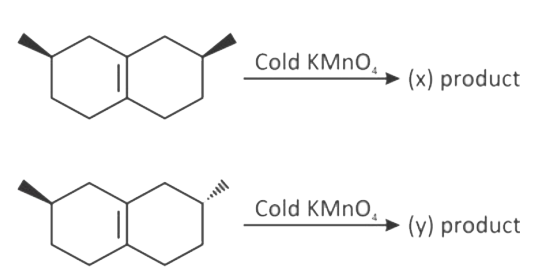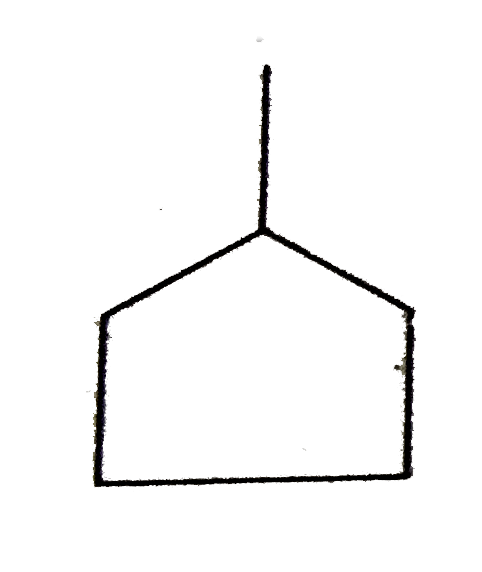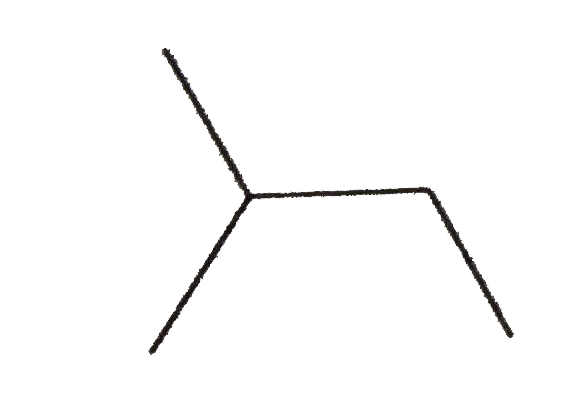C2FClBrI(All isomers)H2/Ni−−−→X (excluding stereoisomers)
Find the value of X+Y
The correct Answer is:5
To solve the problem, we need to determine the number of isomers of the compound C₂FClBrI that can be formed upon hydrogenation, excluding stereoisomers. The hydrogenation process will convert the double bonds into single bonds while adding hydrogen atoms.
1. Identify the Structure of C₂FClBrI:
- The compound consists of two carbon atoms (C), and each carbon is bonded to one of the halogens: fluorine (F), chlorine (Cl), bromine (Br), and iodine (I).
- The general structure can be represented as C=C(F)(Cl)(Br)(I).
2. Determine Possible Isomers:
- We need to consider all possible arrangements of the halogens around the carbon-carbon double bond.
- The possible isomers can be derived from the different combinations of the halogens on each carbon.
3. List All Isomers:
- Isomer 1: C=C with F on one carbon, Cl on the other, and Br and I on the same carbon.
- Isomer 2: C=C with F on one carbon, Br on the other, and Cl and I on the same carbon.
- Isomer 3: C=C with F on one carbon, I on the other, and Br and Cl on the same carbon.
- Isomer 4: C=C with Cl on one carbon, F on the other, and Br and I on the same carbon.
- Isomer 5: C=C with Cl on one carbon, Br on the other, and F and I on the same carbon.
- Isomer 6: C=C with Cl on one carbon, I on the other, and F and Br on the same carbon.
- Isomer 7: C=C with Br on one carbon, F on the other, and Cl and I on the same carbon.
- Isomer 8: C=C with Br on one carbon, Cl on the other, and F and I on the same carbon.
- Isomer 9: C=C with Br on one carbon, I on the other, and F and Cl on the same carbon.
- Isomer 10: C=C with I on one carbon, F on the other, and Cl and Br on the same carbon.
- Isomer 11: C=C with I on one carbon, Cl on the other, and F and Br on the same carbon.
- Isomer 12: C=C with I on one carbon, Br on the other, and F and Cl on the same carbon.
4. Count the Isomers:
- After listing all the possible isomers, we find that there are a total of 12 different isomers of C₂FClBrI.
5. Hydrogenation Products:
- Upon hydrogenation (H₂/Ni), each double bond will convert to a single bond, and hydrogen will be added to the same side (syn addition).
- The products will be the same as the isomers listed above, but we will not count stereoisomers.
6. Calculate X:
- Since we have identified 12 isomers, we can conclude that X = 12.
7. Determine Y:
- The problem does not specify Y, but if we assume Y is a variable related to the isomers, we can set Y = 0 for simplicity, as it is not defined in the context of the question.
8. Final Calculation:
- Therefore, X + Y = 12 + 0 = 12.
Final Answer:
X + Y = 12
- The compound consists of two carbon atoms (C), and each carbon is bonded to one of the halogens: fluorine (F), chlorine (Cl), bromine (Br), and iodine (I).
- The general structure can be represented as C=C(F)(Cl)(Br)(I).
- We need to consider all possible arrangements of the halogens around the carbon-carbon double bond.
- The possible isomers can be derived from the different combinations of the halogens on each carbon.
- Isomer 1: C=C with F on one carbon, Cl on the other, and Br and I on the same carbon.
- Isomer 2: C=C with F on one carbon, Br on the other, and Cl and I on the same carbon.
- Isomer 3: C=C with F on one carbon, I on the other, and Br and Cl on the same carbon.
- Isomer 4: C=C with Cl on one carbon, F on the other, and Br and I on the same carbon.
- Isomer 5: C=C with Cl on one carbon, Br on the other, and F and I on the same carbon.
- Isomer 6: C=C with Cl on one carbon, I on the other, and F and Br on the same carbon.
- Isomer 7: C=C with Br on one carbon, F on the other, and Cl and I on the same carbon.
- Isomer 8: C=C with Br on one carbon, Cl on the other, and F and I on the same carbon.
- Isomer 9: C=C with Br on one carbon, I on the other, and F and Cl on the same carbon.
- Isomer 10: C=C with I on one carbon, F on the other, and Cl and Br on the same carbon.
- Isomer 11: C=C with I on one carbon, Cl on the other, and F and Br on the same carbon.
- Isomer 12: C=C with I on one carbon, Br on the other, and F and Cl on the same carbon.
- After listing all the possible isomers, we find that there are a total of 12 different isomers of C₂FClBrI.
- Upon hydrogenation (H₂/Ni), each double bond will convert to a single bond, and hydrogen will be added to the same side (syn addition).
- The products will be the same as the isomers listed above, but we will not count stereoisomers.
- Since we have identified 12 isomers, we can conclude that X = 12.
- The problem does not specify Y, but if we assume Y is a variable related to the isomers, we can set Y = 0 for simplicity, as it is not defined in the context of the question.
- Therefore, X + Y = 12 + 0 = 12.
X + Y = 12
Similar Questions
Knowledge Check
- Question 1 - Select One
SiCl4H2O−−→XHeat−−→YNaOH−−−→Z
find X,Y,Z.ASiO2SiNaSiBSi(OH)4SiO2Na2SiO3CSi(OH)4SiSiO2DSiO2SiCI4Na2SiO3 - Question 2 - Select One
Consider the following reaction sequence ,
CH3CH(OH)CH3ConcH2SO4−−−−−−−−→HeatXdil.H2SO4−−−−−−−−→H2OY
X and Y in the reaction respectively areACH3CH=CH2,CH3CH(OH)CH3BCH3CH=CHCH3,CH3CH2CH2OHCCH3CH2CH=CH2,CH3,CH2CH2OHDCH3CH2CH2CH3,CH3CH(OH)CH2CH3

Find the value x+y2 (include sterio isomers)View SolutionConsider the following reaction
 Cl2−−→hv total number of mono chlorinated product =x
Cl2−−→hv total number of mono chlorinated product =x
 Cl2−−→hvtotal number of mono chlorinated(Exluding stereoisomer)product=y
Cl2−−→hvtotal number of mono chlorinated(Exluding stereoisomer)product=y
identify value of x+y?View SolutionCl−O∣∣C−OC2H5(1)'X'RMgX−−−−−−−−−→NH4Cl3∘ Alcohol. Find out value of 'X'.
View Solution (A) overset(NaNO_(2)//HCl)underset((ii)H_(2)//Ni)underset(0-5^(@))(rarr)(B) , is: View Solution
(A) overset(NaNO_(2)//HCl)underset((ii)H_(2)//Ni)underset(0-5^(@))(rarr)(B) , is: View SolutionC2H4Br2−−→XKCN−−→Y,Y is
View SolutionFeCr2O4+Na2CO3+O2Fusion−−−→[X]H+−−−−−→H2O[Y]H2O/H+−−−−−→[Z]
Which of the following statement is true for the compounds [X], [Y] and [Z]?View Solution

